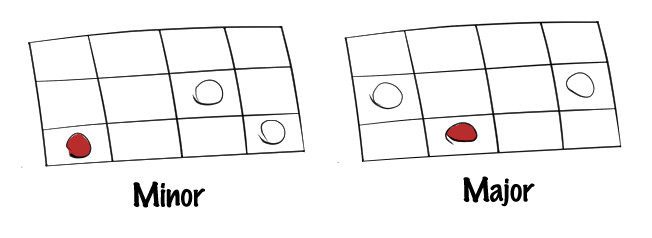How can you create a bassline which doesn’t only consist of the root note of every chord? And what other possibilities are there when it comes to note choice? This article features some tips and tricks to create more elaborate and interesting basslines. Let’s get started!
When you add extra notes to a bassline, how do you choose them?
That’s a good question! If you hear a bass player adding notes to his basslines which aren’t the root note, he doesn’t simply pick a random note and hopes for the best. To determine what notes will sound good at a certain point in the music, you have to be aware what the harmony is.
When presented with a new song, you should always ask yourself two questions:
- What is the key to the song I am playing?
- What are the chords that are being played?
To be able to use a hands-on, practical approach to this lesson, let me introduce a little four bar sequence that could be a song:

Determining the key signature of a song
If you play the above example (just play root notes). You will soon find out that the key is D. How do you determine the key signature of a song? Well, there are a few indicators. The most important one being the feeling the D chord has. Once you played the four bars and play the first bar again, you get this feeling of returning “home”. This feeling tells you that you have returned to the key center. Therefor, D is the key.
Another way to figure this out, is looking at the key signature that you see at the beginning of the staff. Because you see two sharps at the beginning of the musical staff, you can deduce the key of this piece is D. Check out this page if you want to learn more about determining the key signature by looking at the accidentals.
A third way that tells me that the key here is D, (and is maybe not so obvious) is that I see three major chords in this progression. The D, G and A. When you harmonize a major scale in the traditional way, there are only three major chords in a key. Namely; the I, IV and V chords. If you want to learn more about these chord relations, check out my article about modes.
What are the chord qualities?
In the above chord sequence, there are two different chord types. Minor chords (B minor and E minor), which have the suffix “MI” behind the root note, and Major chords (G major, A major and D major), which don’t have a suffix behind the root note.
Why is it important to know whether a chord is major or minor? This is important because it determines what other notes you can find in the chord. The first notes besides the root note that you can add to your basslines, are the notes that are inside the chord.
If you haven’t read my lesson about how chords are constructed, now is probably a great time. You can check it out via “How do chords work? Major, minor and diminished“. The way major and minor chords are constructed are:
- Major: 1 – 3 – 5. So the root note, the major third and the perfect fifth. For the D chord this would be D, F#, and A.
- Minor: 1 -b3 – 5. So the root note, the minor third and the perfect fifth. To compare it to the D major chord, let’s pretend we have a D minor chord in this composition. For a D minor chord the notes would be D, F (a half step lower than the major third in the D major chord) and an A.
As you can see, the difference between a major and a minor chord is the third of the chord. More importantly than being able to name every note inside a chord, is being able to play the right shape that corresponds to the chord. The shapes are:

The red note indicates the root note. Play the notes separately, one by one. This is called an arpeggio. The place on the neck of your bass where you start the shape determines what arpeggio you are playing. So on the first chord in our composition (D major), you should play the major shape starting on the fifth fret of the A string.
Adding chord tones to you basslines
So to summarize what we have just learned: The first step you can take in adding notes to your basslines, is using the other tones that are inside the chord. You can use one of the two shapes I’ve just shown you depending on whether a chord is major of minor.
Expanding beyond the chord tones
Man, these chord tones sound good and everything, but what else can I add? Another good question! There are a lot of things you can still add, but let us start with two of the most used scales in the bass business. The pentatonic major and minor scales. I highly suggest you read my article about using the pentatonic scales for great basslines. It introduces the next two shapes that you can use:

Just like the other shapes I have shown you, the red notes indicate the root notes on which you should start the shape. The shapes in the left and right column contain the same notes but are just different fingerings you can use depending on whatever is most convenient for you in that moment.
As you probably already suspected, you can use the minor pentatonic scale on every chord that is minor. You can use the major pentatonic scale on every chord that is major. In my lesson about using the pentatonic scale I added a video where I used the pentatonic scales in a real life situation. Check it out by clicking here.
I’ve also written a lesson in using the minor pentatonic scale in creating cool bass fills. If that is something you would enjoy, you can click here.
Using the modes in your bass lines
If your belly still isn’t full from the chord tones and the pentatonic scales, the next step you can take is utilizing your modes in your basslines. Dude, what are modes? A mode is a seven note scale (eight if you count the octave) that you can play over a certain chord in a key. There are seven different modes in a major key. When you know the key of a song, you can easily determine which mode you can play over which chord.
Which mode you can use where, depends on the relation of the chord to the key signature. Utilizing modes is a concept that definitely deserves it’s own lesson. Elaborating on the concept here would only make this article unnecessarily long. If you want to learn more about modes. it is best you read my article “Better basslines How do you use modes on bass?“. You can find some great examples of applying modes in my series “Groove Backpack” as well.
Chromatic passing tones
To spice up your basslines you can add chromatic passing tones to your lines. These are notes that are not necessarily part of the key in the song, but have a strong sense of wanting to resolve to a note which IS part of the notes in the key of the song.
Can you give an example? I sure can! If you check out Chameleon by the Headhunters, you hear the synth bass playing four chromatic notes at the beginning. Namely, G, Ab, A, Bb.
The A is actually not in the key of the song, but because it leads up/resolves to the Bb, it sounds very cool. Try to experiment with this. The most important thing is to lead up to a note that is in the key.
You can use chromatic notes below, and above the note you are leading to.
Can I play other notes than the root note on the first beat of a bar?
I’ve had this question before from students of mine so I want to be sure to address this. It can be possible to play another note than the root note of a chord on the first downbeat of a bar. It happens that you play a third or fifth, or sometimes even something more exotic than that, as the note on the first beat.
In jazz music it’s very normal, but in every other style I would watch out with doing that on a whim. If you have decided on it and the whole band knows, it’s fine. The chord players can adapt their chord voicings to it. When you spontaneously decide to do it and either of the chord players plays a different root note in your register, it will sound pretty horrible.
The reason it often does work in jazz groups, is that jazz players usually (hopefully) don’t play in “your”register. They leave out the root note in their voicings to prevent unwanted clashing tones.
To summarize
So to summarize how you can add other notes than the root notes to your playing, is by first determining the key of the song and the qualities of the chords (are they major or minor). If you know those two things you can use:
- Chord tones;
- The pentatonic major and minor scales;
- The modes;
- And chromatic passing tones.
When applying these new concepts don’t try to add everything at the same time. First work on adding just chord tones for a while before you expand on adding the pentatonic scales. Then work on adding the pentatonic scales before applying the next concept.
Be sure to listen to a lot of your favorite basslines and bass players and transcribe what they do. Try to determine what concept they applied to writing the bassline.
Even though this article was about note choice, don’t underestimate how important rhythm and locking in with the kick drum is. Sometimes by just changing the rhythm, you don’t need much more than the root note. We will expand on this concept in a future lesson.
If you want to learn more about what makes a bass lines great, check out my article “How to write better basslines: The 4 ingredients“. Also take a look at my series Groove Backpack where I give you examples of bass lines that you can apply in real life situations. The lessons include videos and a transcriptions (bass tabs and standard notation).
I hope you found this article helpful! Let me know in the comments what your thoughts are and if you have any questions or suggestions.

